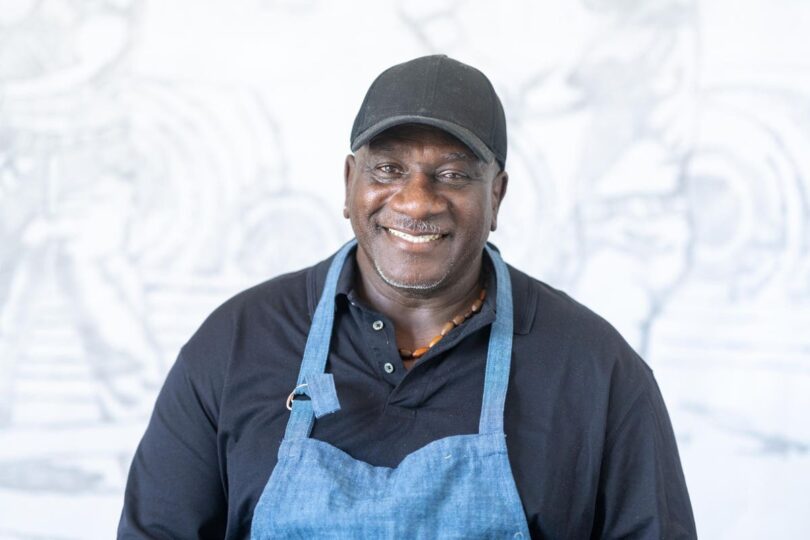Recently, I went over the Brewery Arts complex in the Lincoln Heights section of LA (East of Chinatown) to meet with Gary Tyler in his studio.
Artist Gary Tyler in his studio
Tyler’s first exhibition, We Are The Willing, is currently being held in Detroit at the Library Street Collective through September 6th and is curated by Allison Glenn who was Senior Curator at Public Art Fund and Crystal Bridges Museum. Much of Tyler’s art are quilts that he makes. He told me that when he started to work with quilts, he realized that “I’d found my calling.” He recalled his mother sewing, and his grandmother making quilts. It was in his blood.
Butterfly quilt by Gary Tyler
Tyler’s work is at once simple and complex. He uses a variety of decoupage styles and techniques and various fabrics to fashion his portraitures on quilts. Many of the images are of a young man, often Tyler himself, and sometimes that man is behind bars in prison. The butterfly, a symbol of transformation and of beauty, is also prevalent in Tyler’s artwork. Tyler’s work is at the same time seemingly simple, but complex in its execution, and powerful to look at.
However, in Tyler’s case, it is hard to talk about the Art without talking about the artist. So, let me start by telling you not just who Gary Tyler is; but what he is. He’s a remarkable person, a very special person, filled with warmth, self-knowledge and free of the bitterness he could well carry. He is exceptional in so many ways and an artist who learned about life and making art in the strangest of places: Angola Prison in Louisiana.
When you meet Tyler today, you would not know he’d been sentenced to execution at age 17 and spent 42 years in prison, many of them on death row for a murder he didn’t commit —a black youth framed by the police because he talked back to them, a black teenager convicted because a white youth had been shot when a school bus of black children was attacked by demonstrators protesting against integration – in 1974 almost a decade after the Civil Rights Act had passed, some twenty years after the Supreme Court decision in Brown vs. Board of Education mandating public school integration.
Gary had been raised in St. Charles Parish, Louisiana but in 1970 when he was 11, he went to live with his older sister in the Watts section of Los Angeles. In LA, for the first time, Gary experienced Black pride, and was exposed to activists from the Black Panther Party and the US Organization (United Slaves, or US Black People organization) who, in the aftermath of the 1965 Watts Riots, stood up to the police and stood up for themselves. Gary was exposed to new ways about thinking about himself and about the rights Black people had in America.
However, as he became a teenager, there was more and more conflict with his sister. “You get to the point where you think you know everything…” Tyler said. At the same time, Watts was becoming increasingly dangerous as the kids that he went to school with would be eventually involved in selling crack cocaine and gang violence.
So Gary was sent back to Louisiana. But just as you can’t put the toothpaste back in the tube, in Louisiana Blacks were supposed to know their place, and Gary was having none of it. On October 7, 1974, as a sophomore at Destrehan High School in Destrehan, Louisiana, a town of 11,000 near the Mississippi, Gary was in a school bus filled with black students when it was attacked by a white mob enraged over school integration (and this was 1974!).
A shot was fired and a 13-year-old white boy standing outside the bus collapsed, mortally wounded. Gary saw the police trying to arrest his cousin, putting their knee on his neck, and Gary shouted that what they were doing was unconstitutional. The police then arrested Gary for disturbing the peace and interfering with a police officer doing his duty. While being held, the police beat Gary savagely to get him to confess to the murder. Although he didn’t, the police were able to get several other students to implicate Gary after questioning, and in some cases, beating them.
No gun was found either on Tyler or on the bus after a search. However, a subsequent search ‘found” a gun hidden in one of the bus seats. That gun disappeared from custody but eventually Tyler’s defense attorneys would determine that the gun had been stolen from a firing range used by officers of the sheriff’s department. All of the witnesses against Tyler would also eventually admit to false testimony coerced by the police.
Despite all this and despite being a juvenile, Tyler was convicted and sentenced to die in the electric chair by an all-white jury.
Tyler, at the time he was incarcerated, was the youngest person on Death Row in America. At Angola, the other Death Row inmates were “some of the most negative forces in the prison” Tyler said, “as well as some of the most political of prisoners,” including activists such as Herman Wallace and Albert Woodfox. These men, Tyler said, despite the life they had led, or were living in prison, nevertheless felt that they couldn’t just sit back and let this young kid fend for himself. “I had the best of both worlds. They helped me navigate prison life.”
Tyler learned that prison was about “being respected. That’s what most men want from each other. Respect. If you respect me, I’m going to respect you.” As Tyler told me, “In prison, you need to earn respect – it’s not a given. It’s about “how well you conduct yourself in prison.”
Quilt by Gary Tyler
Tyler, and his family, and attorneys, and supporters worked tirelessly for his release. Tyler’s wrongful incarceration became a cause supported by many important activists, including Rosa Parks. Eventually, the Supreme Court would rule that Louisiana’s death penalty was unconstitutional, and the Firth Circuit would rule that a juvenile can’t be sentenced to death and that Tyler should have a new trial. The Louisiana Board of Prisons recommended Tyler for parole on three separate occasions. However, at every turn, and at every opportunity, Louisiana found a way to keep Tyler on Death Row, and then in prison.
There were “Free Gary Tyler” marches, and “Free Gary Tyler” T-shirts, and Bob Herbert, the celebrated New York Times columnist, wrote several times about Tyler’s wrongful incarceration including in 2007 when he wrote: “There is no longer any doubt that the case against the teenager, Gary Tyler, was a travesty. A federal appeals court ruled unequivocally that he did not receive a fair trial. The Louisiana Board of Pardons issued rulings on three occasions that would have allowed Mr. Tyler to be freed…But this is the South and Mr. Tyler was a black person convicted of killing a white. It didn’t matter that the case was built on bogus evidence and coerced witnesses, or that the trial was, in the words of the U.S. Court of Appeals for the Fifth Circuit, “fundamentally unfair.” Mr. Tyler was never given a new trial and the pardon board recommendations were rejected by two governors.”
And so, Tyler remained in prison. Decades went by. Men he knew on Death Row were executed and that affected him profoundly. Even when Tyler sought to pursue education in prison, he was denied the opportunity because he was on death row. The State saw no interest in educating a man who they were going to put to death.
Nonetheless, the men on Death Row prepared Tyler for being released into the General Prison population. “I learned if you really want something you have to fight for it.”
“There’s a saying in prison, “don’t do time, let time do you,” Tyler told me. “How you interpret that is how you set the course of your life in prison.”
Quilt by Gary Tyler
When he was finally removed from Death Row and placed in the general population, Tyler joined the Angola Prison drama club, where he wrote and put on plays. “We came up with a play called: Who Has The Right? About the death penalty.” Tyler was president of the drama club for 28 years. Their motto, We Are The Willing, is also the name of Tyler’s art exhibition in Detroit,
Tyler also became a leader in prison of the United States Junior Chamber, also known as the Jaycees, that had an Angola branch to help young men develop personal and leadership skills including financial planning and public speaking.
Tyler also got involved in the prison hospital volunteer program. Tyler had known many men who had died in prison, some of them alone in a room. When he was asked to be a hospital volunteer, he agreed. At first, he wasn’t sure he was cut out for it. “It is difficult to be with someone who you know only has a short time left,” Tyler said. But, in time, he decided he could take it. “We learn to adapt,” Tyler told me.
At first, Tyler worked repairing and maintaining hospital equipment and wheelchairs in a repair room. Some of the other hospital volunteers were hospice workers, caring at that time for AIDS patients in the prison.
The hospice program wanted to find a way to express their thanks and appreciation to their volunteers and decided to make them a quilt. They asked Tyler if they could use his workroom to make it. He agreed.
Gary Tyler working in his studio
Eventually, they asked Tyler if he wanted to participate. At first, Tyler recalled, he thought, “I’m not doing any sewing,” But then they started showing Tyler how to cut fabric and how to make the quilt. “And I got hooked,” Tyler says, laughing. He had a revelation: He recalled his mother making clothes from JC Penny catalogues. And he recalled his grandmother making quilts. “So it was like one of those things where… Hey, wait a minute, this is my calling.” Tyler would go on to sell his quilts at the Angola Prison Rodeo. Tyler also made paintings and shadow boxes using found materials such as matchsticks and cigarette boxes. He became an artist.
Gary Tyler had been in prison for more than forty years, when his attorneys including Brian Stevenson, executive director of the Equal Justice Initiative, were able to make a deal with Louisiana prosecutors. They agreed to vacate Tyler’s conviction for first degree murder in return for Tyler pleading guilty to a lesser charge of manslaughter, for which Tyler was awarded the maximum sentence of 21 years. As he had already served almost twice that, he was set free in 2016. However, because he pled guilty, he was not entitled to any compensation or the ability to sue the State of Louisiana.
Tyler found his way back to LA. He was not going to live in the South anymore. And, slowly, while setting his life straight, and readjusting to being back in the world, he continued to quilt, making his striking portraits and creations. In his quilts and his art, the butterfly became his personal symbol, expressing his life’s transformation – from convict to free man.
And, recently, for his show in Detroit, Tyler made a series of self-portraits based on images of him over the years.
In many of these images, the person in it appears to be smiling. Which is incredible given Gary Tyler’s life, and totally Tyler, given the incredible person and artist he is.








